| . 1 . 2 . >> |
| Author |
Message |
Defndr
Member
|
# Posted: 1 Feb 2016 07:45pm
Reply
I have been reading the forum for quite a while now and have got some great tips and ideas. I know this has been covered a few times but I want to make sure I understand it. I am about to do my wiring. I just want to put in a few lights and plugs.
The cabin will be completely off grid. I am using a generator that has a 220 outlet. I purchased a Power inlet box to mount on the outside wall so I can use a standard generator cord to run from generator to cabin. From the inlet box I got some 10/3 wire to go to the breaker box.
I plan on running the black wire and the red wire to the main breaker in my breaker box. The white wire I will put on the neutral strap. The copper ground wire to the ground strap. I will run a wire from the ground strap outside to a rod driven into the ground. Does this sound right?
I am also not sure if I should use the bonding screws in the box to tie the neutral and ground strap together?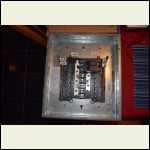
Breaker box
| 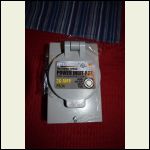
power inlet box
| 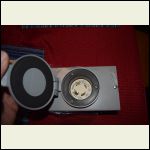
power inlet box 2
|  |
|
|
toyota_mdt_tech
Member
|
# Posted: 1 Feb 2016 07:58pm - Edited by: toyota_mdt_tech
Reply
Easy one....
Hook inlet up using 10/3 with ground (orange sheath on wire, 4 wires total inside the romex). You will have a red, black, white and green or bare wire.
The inlet will have 2 gold screws or an X and a Y designation. This is where the red and black wires will go. The white will hook to the silver screw and the ground or bare wire to the green screw.
Hook to a 30A double pole breaker at the panel (I see you have one, is it 30 amps?), this will act as a main breaker/disconnect. Hook the red and black wire to the breaker, orientation isnt important, white to the neutral bar, left hand side of panel as you look at it from the open end, bare ground or green wire to the ground bar on the RH side.
Now run your circuits off as needed. Does your panel have a bonding method to bond the neutral and ground? I would remove it if it does. Looking at it, it looks like its unbounded and this is where you will want it. . Do not bond this (special instructions may mention bonding, ignore it for this application), use the ground strip at the far right, mounted to the back of the panel directly. Use the one insulted too, just to the right of your breaker for ground and tie it to the one panel mounted. This will ground the panel enclosure too.
When you wire outlets, use line from breaker(s) and then white to the neutral bar, grounds to the insulated neutral bar on the right hand side.
|
|
bldginsp
Member
|
# Posted: 1 Feb 2016 08:17pm
Reply
Don't bond ground and neutral in the subpanel, but make sure that your generator does bond ground and neutral (most home type do, but check). Neutral should be isolated in the sub, and ground is bonded to the sub enclosure. Be sure you have a solid ground path back to the generator. Kudos on the ground rod. The breaker on the generator should also be 30 amps, which most are on these generators. Actually you could go 40 amp on the generator with #10 wire I believe, but 30 is safer.
|
|
bldginsp
Member
|
# Posted: 1 Feb 2016 08:21pm
Reply
Note the green ground screw in your neutral bar, upper right. This bonds neutral to ground by connecting neutral to the enclosure. Remove this, it should only be there if this panel is used as service equipment.
|
|
bldginsp
Member
|
# Posted: 1 Feb 2016 08:23pm
Reply
Quoting: toyota_mdt_tech When you wire outlets, use line from breaker(s) and then white to the neutral bar, grounds to the insulated neutral bar on the right hand side.
The ground bar should not be insulated from the enclosure metal, the neutral should.
|
|
Defndr
Member
|
# Posted: 1 Feb 2016 09:01pm
Reply
Thanks for the replies. That all makes sense.
The double pole breaker that came with the box is not 30amp so I will replace it.
I was a bit confused on the bonding. I will have to check my generator again. I thought I read it did bond ground and neutral but I am not positive.
|
|
bldginsp
Member
|
# Posted: 1 Feb 2016 11:00pm
Reply
Most generators do bond ground and neutral, but it is possible to connect a generator to a system with a transfer switch in such a way that the bond of ground and neutral does NOT occur at the generator, and it's always possible you got one of those, or one that was altered for that purpose. The user's manual should tell you if they connected them in the factory, if they did and you got it new, you're good to go. If there is any question open it up and make sure the neutral is bonded to ground and the metal frame of the generator.
|
|
Defndr
Member
|
# Posted: 2 Feb 2016 09:13am - Edited by: Defndr
Reply
I looked at the generator manual and I'm still not sure if it is bonded. There are 2 sections on grounding. One in the assembly and one in the operations section.
I took a few pictures of the wiring diagram and the manual.
It does have a ground terminal on the front panel.
EDIT: I just found out from the tech department of the generators manufacturer that it has a floating neutral. Does anyone know how this will effect how to hook this generator up to my panel as described above?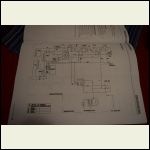
Gen wiring
| 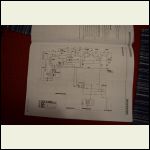
Gen wiring 2
| 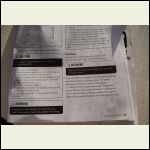
Assembly
| 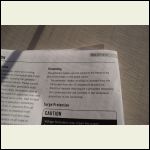
operation
|
|
|
|
bldginsp
Member
|
# Posted: 2 Feb 2016 03:03pm
Reply
A generator with a floating neutral does not bond ground and neutral, read this
http://www.experts123.com/q/what-is-floating-neutral-and-how-does-it-affect-my-genera tor.html
This type of generator is intended to be connected to a transfer switch that does not switch the neutral, so the ground/neutral bond remains in the separate electrical utility service (meter enclosure).
I think in this case you should bond ground and neutral in the sub panel. This can potentially put neutral current into your ground wire system from the subpanel, but this would only occur if the current had a path through the grounds to the source neutral in the genny, which it should not, since the neutral in the genny is isolated. Hope this makes sense. What you are trying to avoid is a parallel path for return current, which can cause electrocution or arcing fire.
With this setup, use the generator only to supply the panel, then run all appliances off the panel. The earth connection of the panel is important, and you should connect the generator frame to the ground rod too.
|
|
bldginsp
Member
|
# Posted: 2 Feb 2016 03:16pm - Edited by: bldginsp
Reply
More:
http://members.rennlist.org/warren/gt5000c.html
A generator with floating, or unbonded, neutral is arguably safer in a stand alone use. But when powering a panel with circuits, you need a ground neutral bond to clear fault current. Breakers won't trip if the ground and neutral are not bonded during a ground fault (short and overload are different).
In the above article he suggests bonding ground and neutral by taking a plug, attaching ground and neutral, and plugging it into a receptacle on the generator, and connecting the ground to the frame of the generator. But he also says don't do this with some Chinese generators. Never heard of this before.
If you know your generator has a floating neutral, bond neutral and ground in a subpanel, keep the wire from the generator as short as possible, and run all appliances off the subpanel. There should still be a ground with the wire from the generator to the panel, and a ground rod connected to genny frame and panel.
If the genny does have a ground neutral bond, do not bond in the panel, make sure there is a ground with the wire from the genny to panel, and connect both to a ground rod as well.
Hope this makes sense.
|
|
Defndr
Member
|
# Posted: 2 Feb 2016 06:17pm
Reply
bldginsp , thanks for taking the time to help me understand this. I really appreciate it. I'm not sure how I missed it but I did find a placard on the generator panel stating "floating neutral".
As of now then I will plan on putting the bonding screws in my panel. I will also drive a ground rod for the panel and one at the generator.
|
|
bldginsp
Member
|
# Posted: 2 Feb 2016 07:53pm - Edited by: bldginsp
Reply
You only need one ground rod, connect both to it. If you do install two rods, they should be connected so the grounding electrode system is one system. Glad I could help.
What is the make, model and wattage of your generator?
|
|
toyota_mdt_tech
Member
|
# Posted: 2 Feb 2016 07:58pm - Edited by: toyota_mdt_tech
Reply
I dont think you want to bond the neutral and ground at the panel unless its a true "neutral". A neutral really doesnt exist in a generator, its line 1 and line 2, not line and neutral. By bonding them, this would tie the generators line to the frame of the generator. I suspect it would pop the gennie breaker or maybe harm the inverter. I suspect the fuse would protect it though.
The ground rods for each is advisable.
A neutral, if you research a "WYE" wound stator, its electrically like a "Y" with each leg being line (3 in this case) and the common tie point in the middle is neutral. If you measured voltage at each "Y" leg to any other leg, you'd get 220VAC (using household as an example) and if you measure from the center point (junction) to any leg, you'd get 110VAC. The center tie point is "neutral". In a generator, the "WYE" doesnt exist at all. You have a single winding, beginning and an end.
In the link bldg insp posted, you will see it says the same thing.
"floating neutral", meaning that the neutral circuit is not connected to the frame or to earth ground. This also means that both legs on the receptacle are hot legs, which is normal for floating neutral generators. As a result, there is no specific hot leg and neutral leg wiring arrangement for the generator winding connection to the receptacle.
Both legs are considered "hot" and putting hot on your generator chassis isn't good. If your ground is tied to the chassis, tying one leg, regardless to the ground will power it up or pop the fuse.
Leave it as a floater, bond your panel grounds and the panel to the ground rod, same as the gennie.
|
|
Defndr
Member
|
# Posted: 2 Feb 2016 10:09pm
Reply
Wow, I sure am learning a lot about this. I see lots of Posts and videos of off grid cabins so I figured it would be a simple thing. LOL
The generator is a 4000/3500 watt Cabela's brand made by Champion, model 46577.
toyota_mdt_tech, maybe I'm not using the right terms. I have one bar in the breaker box labeled ground strap that has a screw bonding or connecting it to the box. I have another labeled neutral strap that can accept a screw to bond it to the box also connecting it to the ground strap thru the box. When you say bond your panel grounds are you just saying leave the screw in the ground strap but not the neutral strap?
|
|
bldginsp
Member
|
# Posted: 2 Feb 2016 11:08pm
Reply
Yes, he's saying leave the neutral isolated and not bonded to the enclosure or ground bar. He might be right, if you have a generator that has no true neutral. Toyota's point that generators are not set up like a residential transformer with a true neutral is a good point, or rather, some are like that and others are not. Perhaps what it boils down to is either knowing exactly what the configuration of the generator is, or asking the tech people who made the generator what to do when powering a panel. I'd like to hear what they say.
|
|
bldginsp
Member
|
# Posted: 2 Feb 2016 11:58pm
Reply
Another good read-
http://members.rennlist.org/warren/generator.html
But he only discusses wiring a generator into a utility powered system for backup with a transfer switch, not powering a panel alone with the generator.
|
|
toyota_mdt_tech
Member
|
# Posted: 3 Feb 2016 09:04am
Reply
Quoting: Defndr toyota_mdt_tech, maybe I'm not using the right terms. I have one bar in the breaker box labeled ground strap that has a screw bonding or connecting it to the box. I have another labeled neutral strap that can accept a screw to bond it to the box also connecting it to the ground strap thru the box. When you say bond your panel grounds are you just saying leave the screw in the ground strap but not the neutral strap?
You do not want neutral bonded to the panel or grounds in this case (its required in cases of primary panels). Neutrals insulated, ground and panel can be bonded. As bldg said, hook them both to a ground rod. Same one can be used for both. Dont get gennie to close to cabin, always CO to watch for.
Hook a circuit tester to your plug on gennie, you will see it will read "open ground" (those plug in items with 2 amber and one red light)
Its because neutral and ground are not connected there either.
|
|
bldginsp
Member
|
# Posted: 3 Feb 2016 03:05pm - Edited by: bldginsp
Reply
If ground is not bonded to neutral somewhere, the circuit breakers will not trip in the event of ground fault, only when there is a short or overload. If the generator does not have a true neutral as Toyota describes, then you can't bond ground to neutral, or neutral to the frame, because it will energize it, if the "neutral" is really a hot.
My Briggs and Stratton generator does have a true neutral that is bonded to the frame and ground. On the other side of things, we know that there are some inverters that produce 120 volts by putting 60 volts in each wire. Such a setup has no neutral and can't be used to power up a subpanel for 120 because it would put 60 volts on each leg. I don't know how many different electrical configurations are used in small generators to result in 120/240. But I do think that many of these units are not intended to power up a subpanel with breakers and circuits.
If I was powering a subpanel with my Briggs generator, I would isolate neutral in the panel because I know that ground and neutral are bonded in the generator. If I had a generator that did not bond ground and neutral, but that I knew had a true neutral, I would bond ground and neutral in the panel. But with a generator that doesn't have the bond and has no neutral, there is no way to set it up to clear fault current in breaker fed circuits. I wouldn't use such a generator for this purpose.
Most small generators are made for two purposes- to be used stand alone with extension cords, or to be used as backup power for power outages. In the second case, they are supposed to be used with a transfer switch. With a transfer switch, you have the option to switch the neutral with the hots or not to. If you do switch the neutral you must bond ground and neutral at the generator, because the switched neutral breaks the ground/neutral bond at the utility service. If you don't switch the neutral, no ground /neutral bond is required at the generator because the bond at the service will direct fault current from grounds to the neutral of the generator bond, completing the circuit that pops the breaker. But in both situations the assumption is that you have a true neutral.
Again I don't know how all generators are configured, but with what I know now I'd say you should not use a generator to power a panel of it has no neutral. So, why would they make a generator with no true neutral? Because they can, and it's probably cheaper. Such a generator will power 120/240 tools, and with breakers it will provide safety against shorts and overload, but not fault current. But there is one argument to be made for such a setup with no neutral or with no bond of ground and neutral at the generator. If there is a bond, and you are holding a tool with a ground fault, and you touch the generator frame, you get a shock. With no ground/neutral bond this can't happen because the neutral is isolated.
So such generators do exist even though they don't meet OSHA rules. But it seems like they are the wrong choice for powering a cabin
|
|
toyota_mdt_tech
Member
|
# Posted: 3 Feb 2016 04:25pm
Reply
Good info bldg. insp.
I have seen some generators with a special rating for construction sites. I think these may be the neutral ones? Not sure.
Anyway, nice research work I might add.
I do use my Honda EU2000i, its an all plastic case, I have my short and overload protection. But I guess I have no fault current protection. I'll just be careful. 
Now I am wondering if my big Honda EU65000is has a neutral. I do have it wired into my house, feed it with the 220V 30A socket. The cost of it, I bet it does have true neutral. I know my home primary panel is bonded.
|
|
toyota_mdt_tech
Member
|
# Posted: 3 Feb 2016 04:38pm
Reply
bldg. insp, suppose the generator really has no ground (not internally connected to anything, which I think it may be) can one bond the panel to the ground and then, would it take care of fault current?
I am going to check now to see if my Honda EU2000i with an all plastic housing has the ground tied in. I do see a spot for a ground wire, suspect a wire going to earth rod etc.
I know my 2000watt inverter has basically no ground also. I suspect it put out same as a no neutral generator.
|
|
Julie2Oregon
Member
|
# Posted: 3 Feb 2016 05:58pm
Reply
Great info! And y'all got me curious so I went to the Home Depot website to check this out.
Honda has a reasonably priced Industrial Generator that has a neutral. It's listed at HD's site.
|
|
pizzadude
Member
|
# Posted: 3 Feb 2016 09:31pm
Reply
Toyota, yes the grounding terminal on the Honda eu2000i is intended for connecting to a grounding electrode, whether it be a stand alone system(in which case you would run a wire from that teminal directly to a ground rod, plate, etc) or to be connected into your on grid grounding system(house panel), provided you have proper means to isolate the normal house power and the power from the genny
|
|
Defndr
Member
|
# Posted: 3 Feb 2016 09:44pm
Reply
bldginsp, I think your correct in that the generator I have is not the one for this job. It has been a great little generator for running tool in areas that I did not have power.
I am going back to the planning stage. I may look into getting a different generator or using this as a good excuse to start putting solar in.
Thank you all for your inputs.
|
|
bldginsp
Member
|
# Posted: 3 Feb 2016 09:56pm - Edited by: bldginsp
Reply
Quoting: toyota_mdt_tech bldg. insp, suppose the generator really has no ground (not internally connected to anything, which I think it may be) can one bond the panel to the ground and then, would it take care of fault current?
For fault current to be cleared, there must be a path back to the power source to complete a circuit. This spikes the amperage and trips the breaker. The bond of ground and neutral does this- it gives the ground wires a path back to the power source via the neutral. If the ground wires have no such connection, it can't clear a fault.
Three phase systems that have no neutral can't be set up to clear a ground fault if only one phase faults. If two fault and the faults occur on electrically continuous equipment, the amperage spikes and fuses blow. But where there is no neutral, you can grab a hot wire and you won't get zapped unless you touch another phase. The reason is there is no path back to the source. So the bad part about using neutrals in electrical systems is that since they give a path back to the transformer, they increase the possibility of getting shocked.
We use systems with neutrals because that gives us the ability to use only one leg of the phase to get 120 volts, rather than using both legs to get 240. The reason we use 120 rather than all 240 is because that's how Edison and the boys set it up, and by the time they figured out that it would be better with 240, Americans already had so many 120v appliances that it would have been expensive and unpopular to convert. So now we have to mess with the problems and confusion created by neutrals, equipment bonding conductors, main bonding jumpers etc.
But maybe that's more than anyone wanted to know
But back to generators, the confusion gets compounded if different generators produce power in different ways- some with neutrals and some without. This is where my knowledge ends- I don't know how generator windings work and I don't know how many different configurations get used. Perhaps someone with more knowledge in this area can enlighten us.
Toyota- your description of a Y transformer is correct, that is one transformer configuration that has a neutral, or 'grounded conductor' as the NEC calls it. Such a conductor comes off the transformer windings in such a manner that it has no potential, but can direct the potential of other 'ungrounded conductors' back to the power source. How this is, or isn't, done with generator windings I don't know.
Hope you're not bored...
|
|
toyota_mdt_tech
Member
|
# Posted: 3 Feb 2016 09:59pm
Reply
Quoting: bldginsp But maybe that's more than anyone wanted to know
Not me, I am a sponge and soak all this up. I never knew about "fault current" before. This has been a real good thread. I am certain it has cleared some questions, but I bet it also created more confusion for some though. 
|
|
toyota_mdt_tech
Member
|
# Posted: 3 Feb 2016 10:03pm
Reply
Quoting: pizzadude Toyota, yes the grounding terminal on the Honda eu2000i is intended for connecting to a grounding electrode, whether it be a stand alone system(in which case you would run a wire from that teminal directly to a ground rod, plate, etc) or to be connected into your on grid grounding system(house panel), provided you have proper means to isolate the normal house power and the power from the genny
Yes, I have my Honda EU6500is set up to power my entire house. I wont go into details, its safe, as long as I am doing it and no one else is authorized to touch the set up. Its always locked up and put away. I do have main disconnects. I understand all about AC and step down transformers that will act as step up transformers when used in reverse like as in a backfeed that isn't disconnected from the main line/grid.
|
|
bldginsp
Member
|
# Posted: 3 Feb 2016 10:13pm
Reply
Quoting: Defndr bldginsp, I think your correct in that the generator I have is not the one for this job
I'm not sure that's true Defndr. If it has a neutral, but it is just not bonded in the generator, you can make a bond in the generator or bond at the panel. You just need to know whether it has a true neutral. I can't tell you this by looking at the wiring diagram. Call the service people and let us know what they think
|
|
Don_P
Member
|
# Posted: 3 Feb 2016 10:30pm - Edited by: Don_P
Reply
Ignore if too far afield,
Quoting: bldginsp Three phase systems that have no neutral can't be set up to clear a ground fault if only one phase faults.
Toyota described a wye 3phase, did you just describe a delta 3 phase?
Edit I think it was Nikola Tesla and George Westinghouse.
|
|
bldginsp
Member
|
# Posted: 3 Feb 2016 10:35pm
Reply
A delta 3 with no midpoint winding
|
|
MtnDon
Member
|
# Posted: 3 Feb 2016 11:27pm - Edited by: MtnDon
Reply
This seemingly simple desire, connecting a generator to a service panel, is more complicated than one would think, if one is attempting to make a 100% NEC compliant installation. The NEC would consider the generator to be a "separately derived system". By definition, a separately derived system is a "premises wiring system whose power is derived from a battery, a solar photovoltaic system, or from a generator and that has no direct electrical connection to supply conductors originating in another system." That is a quote from a friend who heads the electrical maintenance department at a large government installation where my son works.
Another quote; "As such you would bond the neutral bus, the equipment grounding bus, and the grounding electrode conductor (GEC) together at one single point between the source (generator) and the first disconnecting means (the generator outlet panel). Note that the grounding electrode conductor connection must be made "at the same point" as the N-G bond."
Assuming the generator has a circuit breaker the first disconnecting point would be that circuit breaker on the generator. If that is the case, according to him, the bond between the neutral and ground should be at the generator and not the service panel. The GEC (grounding equipment conductor... the wire that connects grounding lug to ground rod in earth) should be at that point as well along with the grounding electrode (rod in ground).
He repeated a couple of times that the bonding jumper must generally be connected at the same point as the grounding electrode conductor. But there are exceptions.
He also noted that the 2005 NEC was the last that would permit a 3 conductor wire for an installation like this.
I don't have a clue myself. But it is the same reason why new clothes dryers (240 VAC) require 4 conductor cords and service instead of the old 3 wire. But the old installations are grandfathered in.
His closing advice to me was to recommend the OP contact a qualified electrician, one familiar with generators as power sources.
|
|
| . 1 . 2 . >> |

